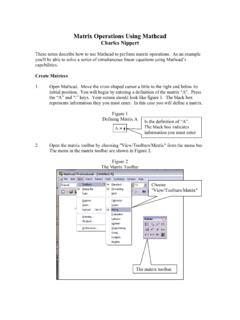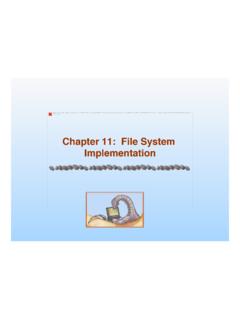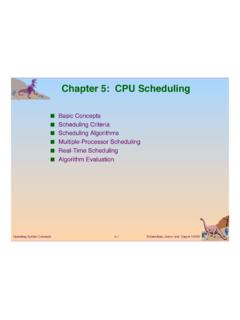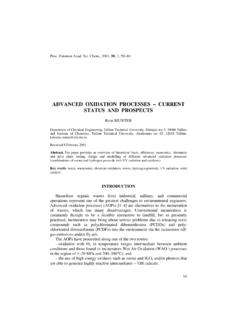Transcription of Chapter 6: Process Synchronization
1 1 Chapter 6: Process SynchronizationChapter 6: Process , Galvin and Gagne 2005 Operating System ConceptsModule 6: Process SynchronizationModule 6: Process Synchronization Background The Critical-Section Problem Peterson s Solution Synchronization Hardware Semaphores Classic Problems of Synchronization Monitors Synchronization Examples Atomic , Galvin and Gagne 2005 Operating System ConceptsBackgroundBackground Concurrent access to shared data may result in data inconsistency Maintaining data consistency requires mechanisms to ensure the orderly execution of cooperating processes Suppose that we wanted to provide a solution to the consumer-producer problem that fills all the buffers. We can do so by having an integer countthat keeps track of the number of full buffers. Initially, count is set to 0. It isincremented by the producer after it produces a new buffer and is decremented by the consumer after it consumes a , Galvin and Gagne 2005 Operating System ConceptsBoundedBounded--Buffer Buffer Producer &Consumer Producer &Consumer ProcessesProcessesProduceritem nextProduced;while (1) {while (((in + 1) % BUFFER_SIZE) == out); /* do nothing */buffer[in] = nextProduced;in = (in + 1) % BUFFER_SIZE;}Consumeritem nextConsumed;while (1) {while (in == out); /* do nothing */nextConsumed = buffer[out];out = (out + 1) % BUFFER_SIZE.}
2 } , Galvin and Gagne 2005 Operating System ConceptsRace ConditionRace Condition count++could be implemented asregister1 = countregister1 = register1 + 1count = register1 count--could be implemented asregister2 = countregister2 = register2 - 1count = register2 Consider this execution interleaving with count = 5 initially:S0: producer execute register1 = count{register1 = 5}S1: producer execute register1 = register1 + 1 {register1 = 6} S2: consumer execute register2 = count{register2 = 5} S3: consumer execute register2 = register2 - 1{register2 = 4} S4: producer execute count = register1{count = 6 } S5: consumer execute count = register2{count = 4} , Galvin and Gagne 2005 Operating System ConceptsSolution to CriticalSolution to Critical--Section ProblemSection Exclusion- If Process Piis executing in its critical section, then no other processes can be executing in their critical If no Process is executing in its critical section and there exist some processes that wish to enter their critical section, then the selection of the processes that will enter the criticalsection next cannot be postponed Waiting- A bound must exist on the number of times that other processes are allowed to enter their critical sections after a Process has made a request to enter its critical section and before that request is grantedyAssume that each Process executes at a nonzero speed yNo assumption concerning relative speed of the.
3 Galvin and Gagne 2005 Operating System ConceptsPetersonPeterson s Solutions Solution Two Process solution Assume that the LOAD and STORE instructions are atomic; that is, cannot be interrupted. The two processes share two variables:zintturn; zBoolean flag[2] The variable turnindicates whose turn it is to enter the critical section. The flagarray is used to indicate if a Process is ready to enter the critical section. flag[i] = true implies that Process Piis ready! , Galvin and Gagne 2005 Operating System ConceptsAlgorithm for Process Algorithm for Process PPiido {flag[i] = TRUE;turn = j;while ( flag[j] && turn == j);CRITICAL SECTION flag[i] = FALSE;REMAINDER SECTION} while (TRUE); , Galvin and Gagne 2005 Operating System ConceptsSynchronization HardwareSynchronization Hardware Many systems provide hardware support for critical section code Uniprocessors could disable interruptszCurrently running code would execute without preemptionzGenerally too inefficient on multiprocessor systems Operating systems using this not broadly scalable Modern machines provide special atomic hardware instructions Atomic = non-interruptablezEither test memory word and set valuezOr swap contents of two memory , Galvin and Gagne 2005 Operating System ConceptsTestAndndSetTestAndndSetInstruct ion Instruction Definition:boolean TestAndSet (boolean *target){boolean rv = *target;*target = TRUE;return rv:} , Galvin and Gagne 2005 Operating System ConceptsSolution using Solution using TestAndSetTestAndSet Shared boolean variable lock.
4 , initialized to false. Solution:do {while ( TestAndSet ( /* do nothing// critical sectionlock = FALSE;// remainder section } while ( TRUE); , Galvin and Gagne 2005 Operating System ConceptsSemaphoreSemaphore Synchronization tool that does not require busy waiting Semaphore S integer variable Two standard operations modify S: wait()and signal()zOriginally called P()andV() Less complicated Can only be accessed via two indivisible (atomic) operationszwait (S) { while S <= 0; // no-opS--;}zsignal (S) { S++;} , Galvin and Gagne 2005 Operating System ConceptsSemaphore as General Synchronization ToolSemaphore as General Synchronization Tool Counting semaphore integer value can range over an unrestricted domain Binarysemaphore integer value can range only between 0 and 1; can be simpler to implementzAlso known as mutex locks Can implement a counting semaphore Sas a binary semaphore Provides mutual exclusionzSemaphore S; // initialized to 1zwait (S);Critical Sectionsignal (S).))
5 , Galvin and Gagne 2005 Operating System ConceptsSemaphore ImplementationSemaphore Implementation Must guarantee that no two processes can execute wait ()and signal ()on the same semaphore at the same time Thus, implementation becomes the critical section problem where the wait and signal code are placed in the critical now have busy waiting in critical section implementation But implementation code is short Little busy waiting if critical section rarely occupied Note that applications may spend lots of time in critical sections and therefore this is not a good , Galvin and Gagne 2005 Operating System ConceptsSemaphore Implementation with no Busy waitingSemaphore Implementation with no Busy waiting With each semaphore there is an associated waiting queue. Each entry in a waiting queue has two data items:zvalue (of type integer)zpointer to next record in the list Two operations:zblock place the Process invoking the operation on the appropriate waiting remove one of processes in the waiting queue and place it in the ready , Galvin and Gagne 2005 Operating System ConceptsSemaphore Implementation with no Busy waitingSemaphore Implementation with no Busy waiting(Cont.)
6 (Cont.) Implementation of wait:wait (S){ value--;if (value < 0) { add this Process to waiting queueblock(); }} Implementation of signal:Signal (S){ value++;if (value <= 0) { remove a Process P from the waiting queuewakeup(P); }} , Galvin and Gagne 2005 Operating System ConceptsDeadlock and StarvationDeadlock and Starvation Deadlock two or more processes are waiting indefinitely for an event that can be caused by only one of the waiting processes Let Sand Qbe two semaphores initialized to 1P0P1wait (S); wait (Q);wait (Q); wait (S);..signal (S); signal (Q);signal (Q); signal (S); Starvation indefinite blocking. A Process may never be removed from the semaphore queue in which it is , Galvin and Gagne 2005 Operating System ConceptsClassical Problems of SynchronizationClassical Problems of Synchronization Bounded-Buffer Problem Readers and Writers Problem Dining-Philosophers , Galvin and Gagne 2005 Operating System ConceptsDiningDining--Philosophers ProblemPhilosophers Problem Shared data zBowl of rice (data set)zSemaphore chopstick [5]initialized to , Galvin and Gagne 2005 Operating System ConceptsDiningDining--Philosophers Problem (Cont.)
7 Philosophers Problem (Cont.) The structure of Philosopheri:Do { wait ( chopstick[i] );wait ( chopStick[ (i + 1) % 5] );// eatsignal ( chopstick[i] );signal (chopstick[ (i + 1) % 5] );// think} while (true) ; , Galvin and Gagne 2005 Operating System ConceptsProblems with SemaphoresProblems with Semaphores Correct use of semaphore operations:zsignal (mutex) .. wait (mutex)zwait (mutex) .. wait (mutex)zOmitting of wait (mutex) or signal (mutex) (or both) , Galvin and Gagne 2005 Operating System ConceptsMonitorsMonitors A high-level abstraction that provides a convenient and effective mechanism for Process Synchronization Only one Process may be active within the monitor at a timemonitor monitor-name{// shared variable declarationsprocedure P1 (..) { .. }..procedure Pn (..) {..}Initialization code ( ..) { .. }..}} , Galvin and Gagne 2005 Operating System ConceptsSchematic view of a MonitorSchematic view of a , Galvin and Gagne 2005 Operating System ConceptsCondition VariablesCondition Variables condition x, y; Two operations on a condition () a Process that invokes the operation is () resumes one of processes (if any) () , Galvin and Gagne 2005 Operating System ConceptsMonitor with Condition VariablesMonitor with Condition , Galvin and Gagne 2005 Operating System ConceptsSolution to Dining PhilosophersSolution to Dining Philosophersmonitor DP{ enum { THINKING; HUNGRY, EATING) state [5] ;condition self [5];void pickup (int i) { state[i] = HUNGRY;test(i);if (state[i] !}}
8 = EATING) self [i].wait;}void putdown (int i) { state[i] = THINKING;// test left and right neighborstest((i + 4) % 5);test((i + 1) % 5);} , Galvin and Gagne 2005 Operating System ConceptsSolution to Dining Philosophers (cont)Solution to Dining Philosophers (cont)void test (int i) { if ( (state[(i + 4) % 5] != EATING) &&(state[i] == HUNGRY) &&(state[(i + 1) % 5] != EATING) ) { state[i] = EATING ;self[i].signal () ;}}initialization_code() { for (int i = 0; i < 5; i++)state[i] = THINKING;}} , Galvin and Gagne 2005 Operating System ConceptsSynchronization ExamplesSynchronization Examples Solaris Windows XP Linux , Galvin and Gagne 2005 Operating System ConceptsSolaris SynchronizationSolaris Synchronization Implements a variety of locks to support multitasking, multithreading (including real-time threads), and multiprocessing Uses adaptive mutexesfor efficiency when protecting data from short code segments Uses condition variables and readers-writerslocks when longer sections of code need access to data Uses turnstilesto order the list of threads waiting to acquire either an adaptive mutex or reader-writer , Galvin and Gagne 2005 Operating System ConceptsWindows XP SynchronizationWindows XP Synchronization Uses interrupt masks to protect access to global resources on uniprocessor systems Uses spinlockson multiprocessor systems Also provides dispatcher objectswhich may act as either mutexesand semaphores Dispatcher objects may also provide eventszAn event acts much like a condition , Galvin and Gagne 2005 Operating System ConceptsLinux SynchronizationLinux Synchronization Linux:zdisables interrupts to implement short critical sections Linux provides.
9 Zsemaphoreszspin , Galvin and Gagne 2005 Operating System ConceptsPthreadsPthreadsSynchronizationS ynchronization Pthreads API is OS-independent It provides:zmutex lockszcondition variables Non-portable extensions include:zread-write lockszspin locks17 End of Chapter 6 End of Chapter 6


















